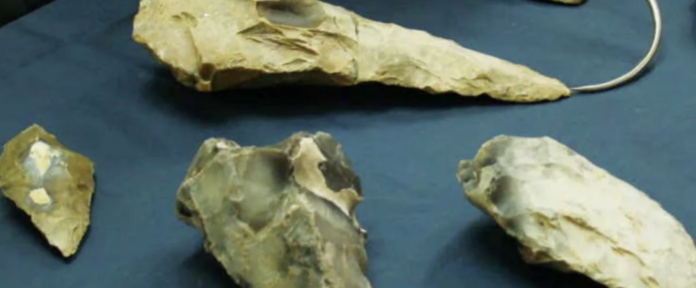Archaeologists in England recently discovered giant prehistoric hand-axes. Scientists are baffled by the size of these 300,000 year-old tools. They are unsure how the Ice Age humans used them.
Researchers from University College London found the hand axes among Ice Age sediments of an ancient river channel located in the Medway Valley, in southeast England. Hand axes found among 800 artifacts on a hillside near Frindsbury in Kent. Artifacts from Manor Farm were discovered in an excavation that began in 2021. The artifacts may have been from the
The giant axes are made of flint and have a base that is thick. They measure over a foot from tip to butt. Scientists are baffled by how prehistoric humans used the large stone tools.
In a press statement, senior archaeologist Letty Igrey of University College London Institute of Archeology stated that “we describe these tools as giants” when they are longer than 22cm. We have two of them. Ingrey stated that one of the hand-axes was the “longest found in Britain.”
Ingrey said, “These hand-axes are huge and it is difficult to imagine that they could have been held or used easily.” Perhaps they served a more symbolic or less practical function than other tools. A clear demonstration of skill and strength.
Ingrey said, “We think of hand-axes as large knives that have sharp and strong edges. They would be perfect for butchering and cutting meat.” We’re not sure whether the size of this axe meant that it was used differently or had a different function. It’s not by chance that ‘giant’ hand axes such as the one we discovered were made in this size. It took a lot of work to create this tool. First, it was necessary to find a large enough piece of flint to create a tool that size. Then it was necessary to flake and shape the long, finely worked tip.
Ingrey stated, “We believe the artifacts are from an interglacial period (warm period) between 330,000 and 300,00 years ago. No human fossils have been found at the site so we don’t know who made it. We do know, however, that Britain at this time was populated by early Neanderthals, but it is possible there were other archaic humans around.”
The Medway Valley was a prime hunting area for prehistoric humans. It would have likely been home to red deer and wild horses as well as the now extinct straight-tusked lions and elephants.
Ingrey acknowledged, “Right Now, we’re not sure why these large tools were made, or which species early humans were making them.” This site gives you the chance to find out.




